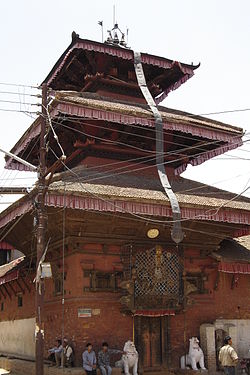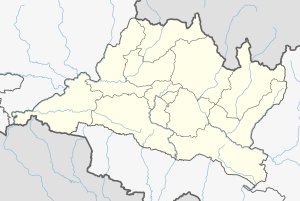Mahalaxmi, Lalitapur
Mahalaxmi Municipality | |
|---|---|
Urban Municipality | |
 The Mahalakshmi - Mahabhairav Temple in Lubhu | |
| Coordinates: 27°38′42″N 85°22′12″E / 27.645°N 85.370°E | |
| Country | Nepal |
| Province | Bagmati |
| District | Lalitpur |
| Established | March 2017 |
| Government | |
| • Mayor | Harigovinda Shrestha (CPN UML) |
| • Deputy Mayor | Laxmi Maharjan (NC) |
| • Socialist | Susan Maharjan |
| Area | |
• Total | 26.51 km2 (10.24 sq mi) |
| Population | |
• Total | 62,172 |
| • Density | 2,345.22/km2 (6,074.1/sq mi) |
| Website | mahalaxmimun |
Mahalaxmi is a municipality that lies in the north-eastern part of the Lalitpur district of Nepal. As per the declaration by the government of Nepal in 2015, it was created through the merger of the Village development committees Imadol, Lubhu, Tikathali, Siddhipur and Lamatar.[1] The city derives its name from the Mahalaxmi-Mahabhairav Temple in Lubhu. The city's total area is 26.5 square kilometres.[2] The municipality has a total number of 10 wards. The old VDC offices are used as joint ward office now .
Name
[edit]Mahalaxmi means Great Lakhsmi (Hindu Goddess) in Sanskrit but with a Nepalized Translation as Nepal is the largest Hindu country by percentage of population adherence in the World. According to the 2011 census, the Hindu population in Nepal is estimated to be around 21,551,492, which accounts for at least 81.34% of the country's population out of 28,095,714. Hinduism arrive in Nepal somewhere in the c. 250 CE but vehemently extended to all of Nepal with Shankara and Prithvi's effort.
Demographics
[edit]At the time of the 2011 Nepal census, Mahalaxmi Municipality had a population of 62,624. Of these, 58.5% spoke Nepali, 26.6% Newar, 6.5% Tamang, 2.1% Maithili, 1.4% Magar, 1.0% Rai, 0.8% Tharu, 0.6% Bhojpuri, 0.4% Limbu, 0.2% Gurung, 0.2% Hindi, 0.2% Sunwar, 0.2% Urdu, 0.2% Wambule, 0.1% Chamling, 0.1% Doteli, 0.1% Sherpa, 0.1% Thulung and 0.2% other languages as their first language.[3]
In terms of ethnicity/caste, 31.0% were Newar, 28.7% Chhetri, 13.5% Hill Brahmin, 7.9% Tamang, 4.7% Magar, 2.4% Rai, 1.4% Kami, 1.4% Tharu, 0.9% Sarki, 0.7% Damai/Dholi, 0.7% Thakuri, 0.6% Limbu, 0.6% Musalman, 0.5% Gurung, 0.5% Sanyasi/Dasnami, 0.4% other Dalit, 0.4% Gharti/Bhujel, 0.3% Teli, 0.3% other Terai, 0.3% Yadav, 0.2% Lohar, 0.2% Majhi, 0.2% Sunuwar, 0.1% Bengali, 0.1% Terai Brahmin, 0.1% Chamling, 0.1% Danuwar, 0.1% Dhanuk, 0.1% Ghale, 0.1% Hajam/Thakur, 0.1% Kalwar, 0.1% Kathabaniyan, 0.1% Kayastha, 0.1% Koiri/Kushwaha, 0.1% Rajbanshi, 0.1% Sherpa, 0.1% Sudhi, 0.1% Thami and 0.3% others.[4]
In terms of religion, 85.6% were Hindu, 8.3% Buddhist, 4.1% Christian, 1.1% Kirati, 0.7% Muslim, 0.1% Prakriti and 0.2% others.[5]
In terms of literacy, 82.1% could read and write, 1.9% could only read and 15.8% could neither read nor write.[6]
Education
[edit]There are many reputed education institutions in this metropolis :
- Mahalaxmi secondary school, Lubhu
- Genius IB World School, Lubhu
- United School, Imadol
- Shuvatara School, Lamatar
- Nepal Don Bosco School, Siddhipur
- Pawan Prakriti H.S, Imadol
- Children Garden School, Imadol
- Anant English School, Siddhipur
- Lalit Academy, Siddhipur
- Kopila English School, Siddhipur
- Mount Olive English Secondary School, Siddhipur
- Siddhimangal Higher Secondary School, Siddhipur
- Bhanodaya Primary School, Siddhipur
- High View School, Tikathali
- Balkunja Secondary School, Changathali
- West Wing School, Lubhu
- Aster Academy, Imadol
- NavaKunja School, Siddhipur
- Mahendra Adarsha Higher Secondary School, Imadol
- Xenium ES
- Peace point secondary school
- Machhapuchhre School, Kusunti
- Kantipur International College Of Engineering, Lubhu
- Bloom Nepal School
Hospital/Public Health Post/Primary Health Post
[edit]- Kist Medical College & Hospital, Imadol
- Lubhu Public Health Center, Lubhu
- Siddhipur Health post, Siddhipur
- Siddhipur Community Health Care Center, Siddhipur
Social Organization
[edit]There are many business or social organizations in Siddhipur
| SN | Organization Name | Type | Established | Nickname | Motto | Logo | Reference |
|---|---|---|---|---|---|---|---|
| 1 | Unification of The Youth | Youth Social Organization | 2073 B.S | UNITY | Youths for social changes. |  |
http://unity.org.np |
| 1 | Firfire Youth CLub | Youth Social Organization | 2076 B.S | Firfire | Platform for all ages group. | http://firfireyouth.club | |
| 2 | Mahalaxmi Yuwa Samuha | Social Organization | |||||
| 3 | Changathali Youth Club | Social Organization | |||||
| 4 | Lalitpur Yuwa Samuha | Social Organization | |||||
| 5 | Satya Yuwa Club | Social Organization | |||||
| 6 | Milijuli Tole Sudhar Samiti | Local Organization | |||||
| 7 | Lamatar Youth Club | Social Organization | |||||
| 8 | Newa Dey Daboo | Social Organization | 2076 B.S. | NDD | Movement For Newa Culture |
Business Organization/Co-operative Organization/Financial Institutions/Other Institutions
[edit]- Kist Medical College & Hospital
- Siddhipur (Thasi) Multipurpose Co-operative Ltd.
- Satya Saving and Credit Co-operative Ltd.
- Sahara Saving and Credit Co-operative Ltd.
- Chandani Saving and Credit Co-operative Ltd.
- Asterix Solution Pvt. Ltd.
- Swavalamban Multipurpose Cooperative Ltd Siddhipur
References
[edit]- ^ "Govt announces 61 municipalities". The Kathmandu Post. 2 December 2014. Retrieved 1 May 2018.
- ^ "Mahalaxmi Municipality | Office of Municipal ExecutiveLalitpur, Bagmati Province"Clean, Green, Prosperous, Full of Beauty-Mahalaxmi Municipality"".
- ^ NepalMap Language [1]
- ^ NepalMap Caste [2]
- ^ NepalMap Religion [3]
- ^ NepalMap Literacy [4]



